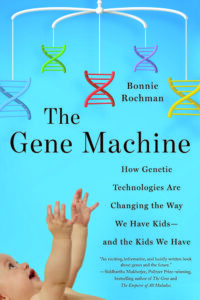Each expectant parent brings their own unique mix of emotions to pregnancy, but all of them share the same hope of simply having a healthy and happy baby.
Couples go through a slew of tests — from blood draws, to ultrasounds and sometimes amniocentesis. Increasingly, they are also turning to genetic testing. These tests include new noninvasive prenatal genetic sequencing to detect abnormalities in the fetus earlier than traditional tests, and even postpartum sequencing for newborns.
While the intent is to ensure the health of their child, these tests can sometimes complicate decisions for prospective parents, and ramp up their anxiety as they determine how best to handle this information.
In the thoughtful book, “The Gene Machine: How Genetic Technologies Are Changing the Way We Have Kids — and the Kids We Have,” journalist Bonnie Rochman tackles some of the thorny issues that arise with these tests.
“(The book) is a road map that helps parents navigate the promise and peril of having children in an age of genetic tests and interventions,” Bonnie said recently.
In some ways the questions that arise from newer genetic testing are no different from those that have arisen in the past, they just come up sooner and add — in both amount and detail — to the information that can be learned.
As Bonnie told the Washington Post recently:
“It’s really important to know who you are as a person, what your mindset is, what you think about information. Do you find lots of information empowering, or does it overwhelm you?”
We spoke with Bonnie about these and other issues that arise and what parents might consider before embarking in some of these types of testing.
23andMe’s Blog: Do you think most prospective parents have these issues on their radar at all?
Bonnie: In dozens of interviews, so many parents told me that they jumped into genetic testing — no matter the specific test — without really understanding what they were getting into. They don’t have a clear picture of what they’re being tested for, what the results could mean, or what they’d do if a problem is detected. I think it’s human nature to err toward optimism, and the moms and dads I spoke with bear this out: they assume they’re going to get reassuring results. Of course, not everyone does. And when the unexpected happens, parents say they feel blindsided.
23andMe’s Blog: What suggestions do you have for parents considering using one of these tests?
Bonnie: Genetic counselors are really invaluable in helping parents decide whether testing in general — and which tests in particular — is right for them. As testing grows more complex and comprehensive, it can help to have someone in the know to walk moms and dads through the pros and cons of various tests. Doctors often don’t have the time to do this, but this sort of hand-holding is genetic counselors’ area of expertise.
23andMe’s Blog: For some time, we have had the ability to use ultrasound and obtain a karyotype (a picture of the chromosomes) from procedures like amniocentesis, and CVS to tell us about potential issues for our unborn children. Why are the current genetic tests thought of differently than those prenatal tests?
Bonnie:
Genetic tests are increasingly relying upon sequencing technology, which allows them to dive deeper into our genome, our genetic code. Some of these tests can help detect Down syndrome in the first trimester, much sooner than was previously possible. So that’s a really significant change. And other deep-dive tests, like chromosomal microarray, can uncover tiny deletions or duplications of DNA that are much smaller than something like the entire extra copy of a chromosome that characterizes Down syndrome. It’s not uncommon for doctors to be uncertain about the significance of these small genetic errors. Do they matter? Are they associated with one genetic condition or another? Our ability to deploy all this amazing genetic and genomic technology has outpaced our understanding about what much of the data means. In many cases, even the experts don’t know. This can create a lot of confusion for parents.
23andMe’s Blog: You mention the gene editing technique known as CRISPR in several places in the book. This highlights both the speed of change in technology, and some pretty basic dilemmas in using this technology. Where do you think all of this is headed?
Bonnie: First off, it’s important to emphasize the polygenic nature of DNA and its influence on traits, which means that in so many situations, it’s a confluence of genes plus environment that determine how traits are expressed. It’s not as if there’s a Baby Einstein gene or a single gene that codes for a killer jumpshot on the basketball court. So we can’t test to determine which embryo is destined to be the next Neil deGrasse Tyson or Steph Curry. As for gene editing, researchers are focused on using CRISPR’s gene modification tools to address disease. While that’s a valid — and valiant — effort, it’s inevitable that some of these technological advances may be co-opted for non-disease-related reasons. For example, there is ongoing work to find a CRISPR-related gene modification to address Duchenne muscular dystrophy (DMD), which affects mostly boys, weakening muscles and leading to death often by the mid-20s. Say we figure out how to “fix” or treat the gene defect that causes DMD. It doesn’t take a huge leap of imagination to envision a world in which some “mad scientists” would say: Hey, we know how to jumpstart muscle growth. Can we do this in athletes?


